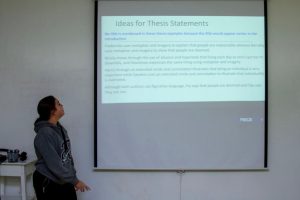In-Class Presentations Teach Students Valuable Skills and Should Not Be Abolished
Having adept public speaking skills is an invaluable asset to possess when entering life beyond high school.
December 11, 2019
Some high schoolers around the nation are advocating for the elimination of in-class presentations. They argue that students with anxiety disorders should not be forced to do anything that could potentially trigger mental distress, and that requiring that students practice public speaking is an unreasonable burden to impose on any and all students, especially those who suffer from anxiety.
However, the practices of public speaking and communications are only becoming more and more vital to enabling success in interpersonal and professional endeavors.
In a 2018 article for Forbes Magazine, keynote speaker and bestselling author Carmine Gallo writes that “as the forces of globalization, automation, and artificial intelligence combine to disrupt every career and to eliminate millions of jobs, the ability to communicate, inspire, collaborate, and motivate became more important, not less.”
Gallo’s point is unarguable — at least, that’s how it should be. The ability to communicate and collaborate effectively is as important as ever for success in almost any workplace or environment.
Cutting students off from the learning experiences provided through in-class presentations would be stripping them of the opportunity to develop a skill set that will promote success in whatever field of study or occupation they choose to pursue.
Even if students think that it would best serve them to avoid in-class presentations, educators and administrators should keep in mind the importance of learning public speaking skills — and on a grander scale, the value of learning to overcome challenges and face difficulties.
It is invaluable to learn how to read and adjust to an audience, how to best organize and articulate ideas by spoken word, and how to effectively present thoughts to others.
For instance, according to a recent survey by the Association of American Colleges and Universities, oral communication is one of the most sought-after skills in the workplace.
80 percent of executives and 90 percent of hiring managers in this study identified oral communication ability as one of the most important traits when hiring, both groups placing it at a higher priority than other intellectual skills such as written communication, complex problem solving, and innovation and creativity.
Another example of the value of public speaking comes from Chris Anderson, who is the curator of TED. In his book, TED Talks: The Official TED Guide to Public Speaking, he writes that “public speaking is the key to unlocking empathy, stirring excitement, sharing knowledge and insights, and promoting a shared dream.”
Despite these clear benefits, students are taking to social media to express their opinions about why they think in-class presentations should be eliminated.
Some say that people should not be forced to partake in something that could potentially induce a panic attack or severe mental distress. Some say that forcing students to give presentations is discriminatory towards those with anxiety disorders. Some say that presentations seem to be graded more on display than on information, and cause more concern about the opinions of peers than the actual information being presented.
A 15-year-old high schooler tweeted that if “someone is too anxious to present in front of the class, they should be given a choice not to. mental health is important. it isn’t cured by ‘facing your fear’.”
I agree with some parts of this argument and others of the sort — it is true that mental health is important. I understand that anxiety can be crippling. It can prevent you from doing things you want to or should do. It can be a fear that seems unconquerable and ineludible.
It’s only natural that the seemingly obvious response would be to avoid and escape the source of that anxiety at all costs. If I’m scared of something, or if it makes me anxious, why would I submit myself to that experience? And why should anyone else force it upon me?
This human response to general anxiety makes sense. In some cases, people who support the abolition of in-class presentations are correct when they claim that anxiety isn’t cured by facing the fear.
For example: If the fear is of vicious sharks or deadly snakes with poisonous venom, I wouldn’t recommend full-blown exposure therapy for a cure to that anxiety. Fears of those rationally dangerous things seem to be more of a helpful protection mechanism than a preventful barrier towards growth or fulfillment.
But in lots of other cases, exposure therapy can be highly effective for overcoming various forms of anxiety. Incremental exposure to the feared situation or object can help break the unhealthy pattern of avoidance and reduce overall fear.
Exposure therapy is widely accepted by psychologists as an effective step towards overcoming or soothing anxiety. Thus, the blanket statement that anxiety “isn’t cured by ‘facing your fear’” is incorrect.
I agree that anxiety and mental illness are real issues impacting adolescents and adults alike all over the world. I agree that speaking in front of peers is not always the best way for everyone to display knowledge. I understand that the objection to giving presentations is more than just laziness or negligence, that it can be a real fear.
But I don’t think the solution to this anxiety should be to get rid of in-class presentations entirely, which would only encourage a cycle of avoidance. I don’t think that we should let fear and discomfort get in the way of something important.
An article by The Atlantic features quotes from several teens who are in protest of in-class presentations. One 14-year-old who was quoted said that “nobody should be forced to do something that makes them uncomfortable.”
The word that sticks out to me here is ‘uncomfortable’. While this individual doesn’t necessarily speak for everyone who shares the same opinion, this seems to be an argument that many people would present in opposition to school presentations — that it’s unfair to require that someone does something ‘uncomfortable’.
This argument is weak and should not convince anyone to favor the removal of student presentations in schools. Though we are often more inclined to play things safe than to place ourselves in uncomfortable situations, and though the expression ‘step out of your comfort zone’ could be viewed as cliché and overused, it can benefit us greatly to face discomfort and attempt to overcome challenges.
However, I know that ‘discomfort’ may be an understatement for some people who struggle with anxiety, and that the thought of giving a presentation can provoke feelings that are comparatively more intense than the minor unease or typical nervousness that many of us experience.
For these more severe cases, there are more reasonable approaches to coping with anxiety than eluding the source and completely removing student presentations from classes.
Simply put, I think that schools should accommodate rather than abolish.
Schools and teachers should find a way to implement public speaking into classes on a daily basis. This may seem contradictory to the idea of reducing stress around presentations, but it’s not infrequent that classes require an end-of-term or unit-concluding presentation that often holds quite a bit of weight in students’ overall grade.
Rather than treating public speaking as the be-all and end-all of a student’s semester course grade, it should be something that encourages practice, allows for errors, and is frequently integrated so that students can become increasingly comfortable with presenting.
Moreover, students should have some autonomy as to the means by which they deliver required presentations. There are many ways to choose to display information, including giving a speech, creating a slideshow, producing and describing artwork, or even songwriting. Presentation methods should reflect the individual’s interests and strengths and be something they want to do.
Another approach is to incorporate more group presentations. This would provide a way to reduce anxiety around public speaking, in that students would not always be subjected to speak in front of a classroom full of people all on their own; rather, they would be surrounded by several other peers. This is an example of small exposure to the fear and could build more confidence in those who struggle with anxiety.
I understand why it is appealing to some people to advocate that in-class presentations be abolished. I understand why it might feel unfair to force students to present, and why it might seem like a disregardance of anxiety and mental illness. My opposition to repealing required presentations is not meant to undermine the gravity of anxiety or to encourage that we sweep mental illness under the rug.
But the issue of mental health is much greater than simply ceasing to require that students give in-class presentations. Rather than promoting that we get rid of public speaking, we should be promoting better mental health support and accessible alternatives for those who suffer from anxiety and any other forms of mental illness.







Elyssia • Dec 12, 2019 at 12:52 pm
Maddie amazing I agree